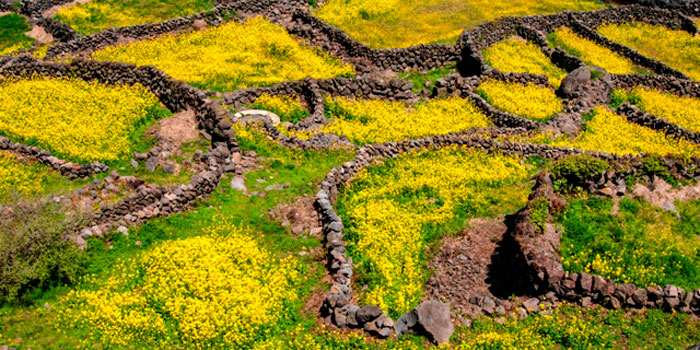Jeju Batdam Agricultural system, Republic of Korea
GIAHS since 2014

Site location: Jeju Island, Republic of Korea
Area of GIAHS: 541 km2
Population working for this system: -
Topological Characteristics: sandy volcanic ash soil
Climatic Classification: warm temperate oceanic
Ethnic Groups/Indigenous People: -
Primary Income Sources: agriculture
------------------------------------------------------------------------
Global importance
Batdam is the result of the ingenuity of Jeju inhabitants to survive in a windy volcanic Island. Utilizing the stones in the soil, they have built stone fences longer than 22,000 kilometer-long to prevent winds, loss of soil and preserving the agricultural culture of Jeju. Jeju Batdam offers an outstanding vista of agricultural culture in Jeju with beautiful natural landscape, representing aesthetics of Jeju.
Protected by Jeju Batdam, called black dragon, agriculture on Jeju Island has survived natural disasters over 1,000 years, but now faces new challenges like farm land arrangement and widespread urbanization.
Food and livelihood security
Agriculture is Jeju allows satisfying most of the needs of the inhabitants with a higher proportion of cultivated dry lands. The most cultivated food crops are potatoes with more than 48 tons, bean, barley, sweet potatoes, white radish, cabbage, carrot, etc.
Moreover, Jeju Island exports cash crops such as sesame, green tea, rape flower, peanuts and medicinal plants. In 2011, 880 000 tons of tangerine and vegetable were exported. Agriculture has changed into commercial agriculture, niche crops have been developed with changes from cash crops to mandarins and from subtropical crops to winter vegetables.
In that sense, dry-field farming and Batdam in Jeju are inseparable and the sustainability of dry-field farming relies on the preservation of Batdam, which is a basis for the farming.
Biodiversity and ecosystem functions
Being part of the agricultural system, Jeju Batdam allows cultivating endemic and rare species of plants and many species of food crops. The flora gathers more than one thousand different species on the Island with also amphibians, reptiles, birds, mammals and insects integrated to the environment.
Jeju Batdam includes a high biodiversity with three different types depending on nearby environments, including Oreum (or hill), Gotjawal (or volcanic forest), stream, wetland, bangdeui and intertidal region.
Knowledge systems and adapted technologies
Jeju Batdam is a core element in Jeju's traditional dry field farming. They are naturally built with stones found in the fields and nearby areas. Indeed, situated near a Volcano, stones are mostly relatively round and porous lava making many gaps. And the gap as an air hole has withstood the strong winds.
Batdam were built in various structures, depending on the soil condition or environmental condition. The types are categorized according to the way a fence was built (single, double line, etc.). Blocking off strong winds, it helps reducing evaporation, favouring seeds sprout, soil erosion, but also helps separating cattle from the fields. Cultivating crop selection depended on the height of Batdam and the quality of volcanic or non-volcanic ash soils.
Cultures, value systems and social organizations
Stones are part of the Jeju culture with general uses including construction, production, everyday lives, religion, tombstones and play while special use include communication, defense and demarcation. Doldam represents stone culture of Jeju within Batdam as a sub-element of doldam in its nature.
Moreover, beyond Batdam, agriculture is very present in Jeju’s folklore and culture through songs, rituals, fields’ memorial and food culture holding 500 traditional dishes.
Remarkable landscapes, land and water resources management features
Thanks to the Batdam fences, Jeju Island is described like having a black dragon. A mosaic of Batdam spreads out across the island, creating more refined and unique cultural landscape of Jeju. It shaped a unique cultural landscape of Jeju Island created by geological nature of the volcanic island.
Allowing developing agriculture on the Island, batdam has been the shaping condition for the Island’s communities to survive. It is the result of work during centuries and must be conserved to ensure the future of dry fields in Jeju.

